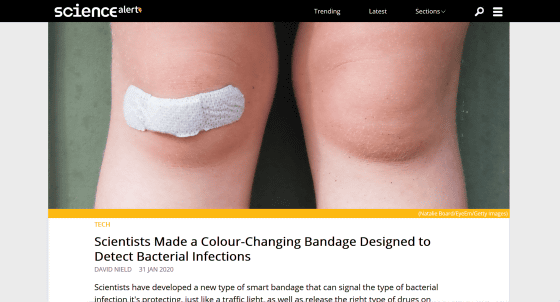A mechanism to optimize treatment is developed by `` bandage that changes color when bacteria infect the wound ''

by
With a resistance to the antibiotic super bugs is a major crisis for humans, many researchers have been exploring the countermeasures to the super bug. Meanwhile, the research team of the Chinese Academy of Sciences has developed a 'bandage that changes color when bacteria infect the wound and can determine whether the bacteria are super bugs'.
Colorimetric Band-aids for Point-of-Care Sensing and Treating Bacterial Infection | ACS Central Science
https://pubs.acs.org/doi/abs/10.1021/acscentsci.9b01104
Smart Bandages Automatically Sense and Treat Bacterial Infections
https://scitechdaily.com/smart-bandages-automatically-sense-and-treat-bacterial-infections/
Scientists Made a Color-Changing Bandage Designed to Detect Bacterial Infections
https://www.sciencealert.com/scientists-have-developed-a-colour-changing-bandage-to-detect-bacterial-infections

Monitoring whether the wound has become infected with bacteria or whether the infected bacteria are resistant to antibiotics is important for optimal treatment. But researching whether the infected bacteria are superbugs generally takes time and requires expert knowledge and expensive equipment, the team said. Therefore, the research team developed a 'bandage that changes color depending on the type of infected bacteria' so that it is possible to determine at a glance whether there is a bacterial infection or a super bug.
The bandage is made of a material that changes from green to yellow depending on the acidity. Normally, the green bandage turns yellow when it touches the wound that has been acidified by bacterial infection. The dressing also contains materials that release antibiotics that kill drug-sensitive bacteria. Superbugs with drug resistance release enzymes in response to antibiotics, but the bandage seems to turn red when it senses this enzyme. That is to say, the bandages turn green when the wound is uninfected or low in bacteria, yellow when infected with drug-sensitive bacteria, and red when infected with a drug-resistant superbug. States.
The image below shows a newly developed bandage applied to the wound of a mouse and the difference in color that appeared when the wound was infected by changing the concentration and type of bacteria. The top row is infected with drug-sensitive bacteria (DS), the bottom row is infected with drug-resistant superbugs (DR), and the left is uninfected In the state, the number of bacteria infecting the wound is increasing toward the right. The colors are the same when not infected with bacteria, but each color changes as the number of bacteria increases, and you can see at a glance whether you are infected with superbugs.

The researchers say that depending on the color of the bandage on the wound, the therapist can choose the right treatment. For example, if the color of the bandage is yellow, antibiotics are administered as usual, and if red, treatment with
In some cases, the bandage turns red after the bandage turns yellow and antibiotics are given. In this case, it can be determined that the bacteria have been turned into a superbug by administration of antibiotics, so that the healer can provide additional treatment and prevent the superbug from acquiring further resistance.
The bandage is easily portable and does not require any special skills to use for the allowance. `` Compared to traditional PDT-based antimicrobial strategies, the method we have developed can reduce unintended side effects of treatment, maximize therapeutic effect and track changes in drug resistance with the naked eye in real time, '' The research team stated.

Related Posts:
in Science, Posted by log1h_ik







